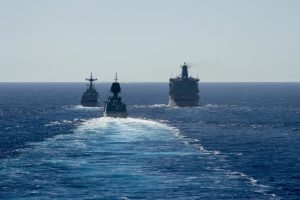The biennial Rim of the Pacific (RIMPAC) exercise began August 17 with reduced participants and featuring only at-sea events to protect participants from the risk of coronavirus infection. RIMPAC is the world’s largest multinational naval exercise, held primarily in the vicinity of the Hawaiian Islands.
In April the U.S. Navy announced that this year’s exercise would not feature the usual shore activities to minimize the number of personnel traveling to Hawaii and risking exposing themselves, partner nation participants, and the residents of Hawaii to possible coronavirus infection. The island of Oahu, home to Hawaii’s principal naval and air bases, is expected to begin new restrictions to control the spread of coronavirus after a spate of new cases concentrated on the island.
U.S. Pacific Fleet Commander Admiral John Aquilino, who hosts the exercise, said “all RIMPAC participants are practicing disciplined COVID mitigations to protect the citizens of Hawaii, the force, and prevent the spread of the virus while gaining invaluable experience working alongside out valued partners at sea.”
According to the U.S. Navy, this year’s exercise features 22 warships from 10 nations, a submarine, multiple aircraft, and approximately 5,300 personnel. Training events will include submarine hunting operations, maritime interdiction, and various live-fire drills.
The 2018 exercise counted 45 surface ships from 26 nations, more than 200 aircraft, and more than 25,000 personnel. That exercise was further notable for the participation of United States’ and Japanese ground forces in a “sinkex” — firing missiles and rockets from mobile launchers at a target ship to demonstrate nascent land-based anti-ship capabilities that have since become a major procurement priority for the United States.
This year’s exercise was supposed to be even bigger, with units from 30 countries and more than 50 ships originally planned to participate, according to Vice Admiral Scott Conn, who will be running the two-week event.
Participants this year include units from the navies of Australia, Brunei, Canada, France, Japan, South Korea, New Zealand, the Philippines, Singapore, and the United States.
Notably, China was not invited. The Chinese People’s Liberation Army Navy was invited to take part in RIMPAC for the first time in 2014 and expanded its participation in RIMPAC 2016. China was first invited and subsequently disinvited from RIMPAC 2018, the first iteration of the exercise held under the Trump administration.
The COVID-19 pandemic has strained the defense budgets of countries responding to extraordinary economic slowdowns caused by measures to control the spread of the virus and outbreaks have sidelined warships. An outbreak on the aircraft carrier USS Theodore Roosevelt left the United States with no carriers deployed at-sea in the Western Pacific for several months this spring. Outbreaks also impacted a Littoral Combat Ship and a destroyer. A similar outbreak forced the French aircraft carrier Charles de Gaulle to cut its deployment short this spring after a third of its crew became infected.

































